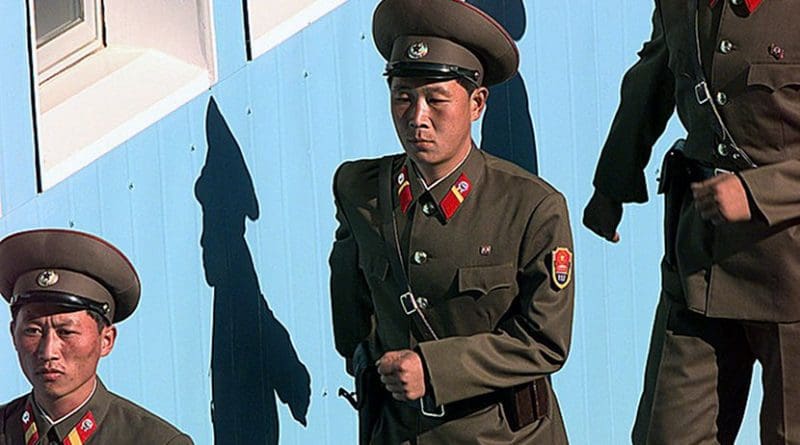North Korea’s Mistranslated ‘Shoot-To-Kill’ Border Protection Order – Analysis
By Martin Weiser
On 25 August 2020, North Korea took another drastic step in its anti-COVID-19 measures by establishing restricted ‘buffer zones’ at its border with China, after already halting most cross-border trade and travel. According to the official announcement, the aim was to prevent any entrance of the virus through unauthorised exchanges that had previously slipped through surveillance.
The measure was adopted by the 17th Enlarged Meeting of the Politburo of the Workers’ Party of Korea (WPK) and went into effect at midnight on 26 August. This quick implementation underlined its perceived urgency. The attendance of Kim Jong-ho, North Korea’s Minister of Public Security, and Ri Jong-rok, reportedly the Deputy Minister of State Security, suggests a major change in domestic security policy.
Just days before the meeting, an ‘emergency anti-epidemic law’ was adopted introducing harsh punishments for quarantine enforcement by officials, including the death penalty or life imprisonment in ‘extremely grave cases’. Around the same time, the Minister of State Security was demoted, allegedly for failing to stop illegal border traffic with China. Whether it was a particular border incident or the decision issued on 19 August to hold the 8th WPK Congress in January, something had raised sensitivities in Pyongyang about the virus entering the country.
According to Radio Free Asia’s (RFA) sources, border troops had received orders by 5pm on 25 August about the implementation of buffer zones at midnight, while citizens were informed the next day by local officials of the Ministry of Public Security. An important part of these measures was, according to one North Korean source, the drastic warning that anybody trespassing within one kilometre of the border would be ‘shot dead’ (sasal).
This narrative of a ‘kill zone’ has been continuously invoked by RFA based on this single testimony and was not questioned by other media — apparently because it confirmed the perception of the North Korean regime as brutal and inhumane. But other available information reveals a more nuanced picture, although the threshold for use of lethal force at the border was indeed lowered.
In early September, Daily NK released further information on the ministry announcement. According to their sources, the announcement only stated the threat of being ‘fired at’ (sakyok) unconditionally or without warning in those buffer zones. This nuance was lost in the Daily NK’s initial English report, released on 7 September, which translated it as ‘shot’. The error was quietly corrected weeks later.
Daily NK’s Twitter account stated on 25 September that its own reporting did not suggest a ‘shoot-to-kill’ order was in place and corrected all English reports shortly after. But only one English article explicitly noted the correction.
A full transcript of the order was first released on 26 October by Rimjingang, a North Korean magazine based in Japan. English translations of the text were then published by NK Pro and later also Rimjingang. Both translations differed markedly and Rimjingang continues to translate sakyok as ‘shot’ like Daily NK initially did. The full text revealed that the order differentiated between ‘unconditional firing on any person’ entering the zones without approval or violating regulations in the border area and ‘firing without warning on any person that trespasses into our riverside’ of the border rivers.
This difference between firing ‘unconditionally’ and ‘without warning’ — which Rimjingang translated both as ‘shot on sight’ — could be understood as an unimportant variation in wording. But Daily NK reported in September that firing was not actually unconditional and came with warning shots: when two smugglers were spotted near the border, a border guard first fired three blanks at them, then used live ammunition because they did not stop moving.
This directly contradicts the RFA source’s claim that the order required all border guards to carry live ammunition only. In fact, the Ministry’s announcement explicitly states that those entering the buffer zones must always carry proper authorisation papers, making it obvious that they would not be ‘shot on sight’.
The same sequence of events — blanks first and live ammunition on further movement — was offered by North Korea to explain the death of a South Korean marine official in September, and previously the death of a South Korean tourist in 2008. Presumably, these rules of engagement are now applied in the buffer zones in a less strict form.
It would be unsurprising if ‘unconditional firing’ still required warning shots. Ministry announcements have frequently threatened the death penalty to deter people from violating orders, and North Korea’s reliance on ‘fear politics’ is often raised by analysts, commentators and defectors. And naturally, announcements to the North Korean public do not exactly mirror the actual orders given to border guards and ministries.
Indiscriminate use of lethal force right at the border would violate what a Daily NK source called in 2016 ‘standard procedure’, a measure still adopted sporadically by North Korea. With the WPK Congress now behind it, hopefully the regime will limit the use of lethal force again. The General Staff of the Korean People’s Army ordered soldiers to avoid using live ammunition ‘unless absolutely necessary’ during the Congress — a grace that could be easily extended.
*About the author: Martin Weiser is an independent researcher based in Seoul.
Source: This article was published by East Asia Forum

